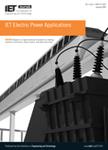版权所有:内蒙古大学图书馆 技术提供:维普资讯• 智图
内蒙古自治区呼和浩特市赛罕区大学西街235号 邮编: 010021

作者机构:Qingdao Univ Coll Automat Qingdao 266071 Peoples R China
出 版 物:《IET ELECTRIC POWER APPLICATIONS》 (IET电力应用)
年 卷 期:2021年第15卷第10期
页 面:1343-1357页
核心收录:
基 金:National Natural Science Foundation of China
主 题:fast dynamic transient response transient response cooperative control motor control system Control of electric power systems state EPCH method Current control predictive control electric current control synchronous motor drives control system synthesis energy consumption sigmoid function Control system analysis and synthesis methods state error port-controlled Hamiltonian method error function velocity control Velocity, acceleration and rotation control DBPC permanent magnet motors Synchronous machines machine control real-time position error Optimal control steady-state performance deadbeat predictive control permanent magnet synchronous motor drives Drives
摘 要:In this article, a cooperative control combining deadbeat predictive control (DBPC) and state error port-controlled Hamiltonian (EPCH) method is presented for permanent magnet synchronous motor drives. This effective combination is achieved by a cooperation scheme based on the error function. First, the DBPC is introduced to provide a fast dynamic response, and the state EPCH method based on the loss model is constructed to get good steady-state performance and high efficiency. After that, to combine the advantages of both controllers, the improved sigmoid function based on real-time position error is designed as a cooperative scheme. Each control method can be utilised effectively within the corresponding range. Meanwhile, the switching process is continuous and smooth without unnecessary chattering. Thus, the proposed method not only solves the contradiction between dynamic and steady performance but also optimises energy consumption. Finally, the proposed method is verified experimentally. The results show that the motor control system based on the proposed method has fast dynamic transient response and good steady-state performance with high efficiency.